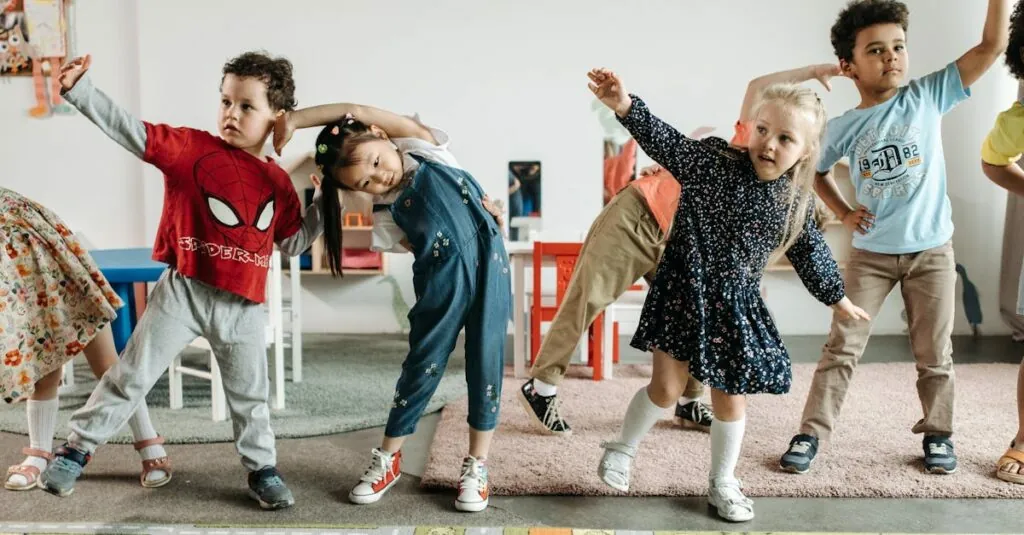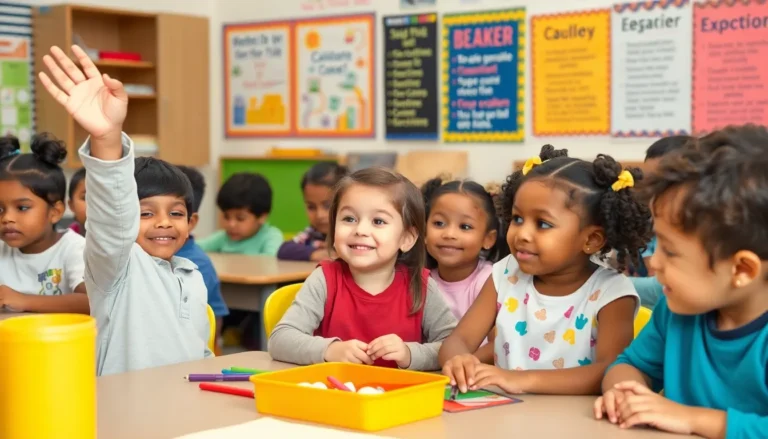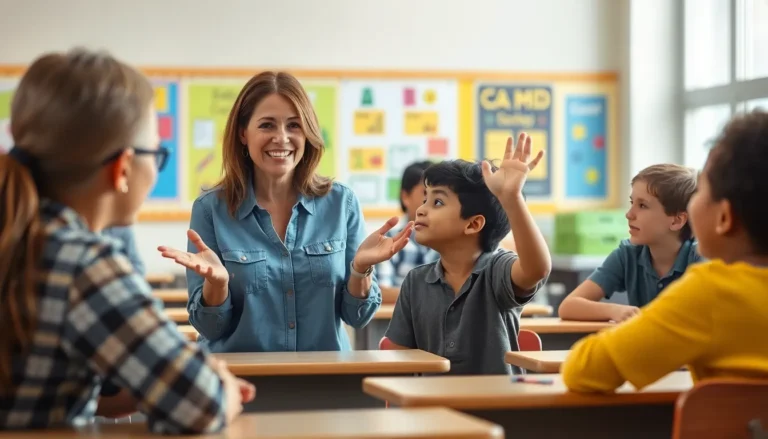Table of Contents
ToggleElementary pupils are the bright sparks of the educational world, bursting with curiosity and energy. These young learners, often armed with backpacks bigger than themselves, embark on daily adventures that transform classrooms into vibrant playgrounds of knowledge. From mastering the art of addition to navigating the complexities of friendship, their journey is both hilarious and heartwarming.
Overview of Elementary Pupils
Elementary pupils embody a unique blend of curiosity and enthusiasm. They explore new concepts daily, making classrooms lively environments. Learning math, reading, and science becomes an exciting adventure full of challenges and discoveries. Social interactions play a critical role in their development, with friendships forming alongside academic growth.
Pupils in this age group, typically aged 5 to 11, thrive on structured learning. They respond well to hands-on activities, which foster engagement and retention. Creativity often emerges through art projects, group discussions, and interactive lessons. Each day presents opportunities for pupils to ask questions, express opinions, and apply knowledge.
Academic curricula frequently emphasize foundational skills. Literacy and numeracy stand as core subjects, crucial for future learning. Essential subjects, such as social studies and environmental science, broaden their understanding of the world. Exposure to various subjects cultivates critical thinking and problem-solving skills.
Teachers play vital roles in guiding these learners. They create supportive environments that promote exploration. Providing positive reinforcement encourages pupils to take risks and persist through challenges. Classroom routines establish a sense of security, enabling pupils to flourish academically and socially.
Parental involvement positively impacts elementary education. Engaged parents reinforce learning at home, leading to improved academic outcomes. Family activities, such as reading together or visiting museums, enhance pupils’ educational experiences. Collaborative efforts between home and school prove beneficial for overall development.
Ultimately, the journey of elementary pupils encompasses more than academics. Their days are filled with laughter, learning, and lasting memories, shaping them into well-rounded individuals.
Developmental Characteristics
Elementary pupils demonstrate distinct developmental characteristics across various domains. These characteristics shape their learning experiences and interactions with peers.
Cognitive Development
Cognitive abilities flourish during elementary years. Pupils develop critical thinking and problem-solving skills through engaging activities and lessons. They grasp fundamental concepts in subjects like math and language arts, laying the groundwork for future academic success. Additionally, exploring hands-on projects fosters creativity and boosts retention. Teachers encourage inquiry-based learning, prompting students to ask questions and seek answers. This playful exploration contributes significantly to their cognitive expansion.
Social and Emotional Development
Social and emotional growth is vital for elementary pupils. Peer interactions play a critical role in developing communication and collaboration skills. Friendships formed in these years provide opportunities for sharing and empathy, essential for emotional intelligence. Moreover, navigating social dynamics helps them construct their identity. Classroom activities that promote teamwork enhance their cooperative skills. Educators support this development by facilitating discussions around feelings and conflict resolution, paving the way for healthier relationships. Nurturing these skills prepares pupils for future social environments.
Learning Styles of Elementary Pupils
Elementary pupils exhibit diverse learning styles that influence how they absorb information. Understanding these styles helps tailor educational strategies to meet individual needs.
Visual Learners
Visual learners grasp concepts through imagery and visualization. These pupils benefit from charts, diagrams, and color-coded notes. Engaging classroom decorations and interactive whiteboards enhance their understanding. Examples include using pictures to accompany vocabulary words or illustrating math problems. Teachers can support these learners with activities like drawing and creating visual aids. Encouraging them to take notes visually can reinforce retention.
Auditory Learners
Auditory learners thrive on listening and verbal communication. Discussions, storytelling, and music foster their learning. They often excel in subjects that involve oral instructions or group discussions. Group projects and read-aloud sessions effectively engage these pupils. Utilizing rhymes and songs to teach concepts aids memorization. Strategies like encouraging them to explain their understanding verbally boost their confidence.
Kinesthetic Learners
Kinesthetic learners prefer hands-on experiences and movement. These pupils flourish with active participation in lessons. Incorporating role-playing games and experiments can enhance their learning outcomes. They often excel when lessons involve building or physically manipulating objects. Providing opportunities for movement during lessons, such as using manipulatives in math, leverages their strengths. Projects that require construction or experimentation also foster deeper understanding.
Classroom Environment and Engagement
A supportive classroom environment significantly impacts elementary pupils’ learning experiences. Positive atmospheres cultivate enthusiasm and promote better engagement. When pupils feel safe and valued, their curiosity flourishes.
Importance of a Positive Atmosphere
Creating a positive atmosphere proves essential for elementary pupils. This environment nurtures a sense of belonging, which enhances motivation and focus. Teachers who encourage open communication contribute to pupils’ confidence and willingness to participate. Emotional safety within the classroom allows pupils to voice thoughts and emotions freely. Research indicates that positive classroom environments lead to improved academic performance and social interactions.
Strategies for Enhancing Participation
Employing targeted strategies enhances participation among elementary pupils. Utilizing interactive activities, such as group discussions or hands-on projects, fosters engagement. Incorporating varied instructional methods caters to different learning styles, ensuring all pupils are included. Providing opportunities for pupils to lead activities boosts their confidence and keeps them actively involved. Recognizing individual contributions encourages participation, making pupils feel valued and connected to the learning process.
Educational Challenges
Elementary pupils face several educational challenges that can impact their learning journey. Learning disabilities and behavioral issues are prominent among these challenges.
Learning Disabilities
Understanding learning disabilities is crucial for supporting elementary pupils. Dyslexia, ADHD, and dyscalculia are common conditions that affect their academic performance. These pupils often struggle with reading, writing, or mathematics, making traditional methods inadequate. Tailored interventions can significantly enhance their learning experiences. Teachers employing specialized strategies, such as one-on-one instruction, provide essential support. Implementing assistive technologies also aids in bridging learning gaps. Identifying and addressing individual needs fosters a more inclusive classroom environment.
Behavioral Issues
Behavioral issues can disrupt the learning process for elementary pupils. Challenges like anxiety, aggression, or lack of impulse control often manifest in classroom settings. Teachers play a pivotal role in managing these behaviors through positive reinforcement and clear expectations. Establishing consistent routines also helps pupils feel secure and focused. Social skills training can further aid in improving peer interactions. Implementing conflict resolution programs equips pupils with essential life skills. By fostering a supportive atmosphere, educators can effectively address and minimize disruptive behaviors.
The journey of elementary pupils is a remarkable blend of curiosity and growth. Their vibrant energy fuels a love for learning that lays the foundation for future success. With the right support from teachers and parents, these young learners navigate challenges while forming friendships and developing essential skills.
Creating a nurturing classroom environment is crucial. It fosters engagement and encourages pupils to express themselves freely. By recognizing diverse learning styles and addressing individual needs, educators can enhance the educational experience, ensuring that every pupil feels valued.
Ultimately, the experiences and memories formed during these formative years shape well-rounded individuals ready to take on the world. Embracing this journey is vital for nurturing the next generation of learners.





